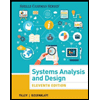
Business Driven Technology
7th Edition
ISBN: 9781259567322
Author: Paige Baltzan Instructor
Publisher: McGraw-Hill Education
expand_more
expand_more
format_list_bulleted
Concept explainers
Expert Solution & Answer
Chapter 2, Problem 3MBD
Explanation of Solution
Michael Porter:
- Michael Eugene Porter is an economist, researcher, author, advisor, speaker, and teacher.
- His research is widely being recognized in governments, corporations, NGOs, and academic circles around the globe.
- He has received numerous awards, and he is the most cited scholar today in economics and business. He has even achieved remarkable acceptance by practitioners across multiple fields.
- He has brought economic theory and strategy concepts to bear on many of the most challenging problems facing corporations, economies and societies which include market competition, economic development, the environment, and healthcare.
- He is an author of 18 books and many articles which include Competitive strategy, On Competition, etc...
Expert Solution & Answer
Want to see the full answer?
Check out a sample textbook solution
Students have asked these similar questions
Review the Hubspot articleLinks to an external site. on how to do keyword research for SEO from Hubspot, to include the embedded video. Now, walk through the steps in the article. Pick a business or organization. Make a list of important topics for this business or organization. Next, create keywords for each of the topic areas. Then, select ten of your keywords and enter them into a search engine, like Google. Make note of the results. Then, tell us:
What factors did you consider when deciding on your topics?
What factors did you consider when deciding on your keywords?
What were the results of entering your keywords into the search engine?
What related search terms appeared when you plugged in specific keywords into your search engine?
Respond to two others by addressing their decisions, actions, and results.
3.
| The following program undergoes scope checking using a stack of symbol tables:
1.
void main() {
2.
5.
6.
7.
8.
int a; int b%3B int c%;B
if (a == b) {
float c%;B
for (int c = 1; c <10%;B c++ ) {
cout << a;
9.
}
10.
}
11.
12.
13.
int a;
else {
} /* else */ } /* main */
(a) [10] Draw the symbol tables created for this program as follows: List in each sym-
bol table all the identifiers in that scope as pairs (identifier,type). Then draw the links
(pointers) between the symbol tables that establish the stack structure.
(b) [5] Let the scope checking algorithm process line 8 of the program. Identify in your
answer to the previous question the symbol table corresponding to the current scope as
well as the symbol tables corresponding to all the open scopes. Explain then how are
the symbol tables inspected to obtain the type of variable a.
5
In C++ private inheritance all the members of the base class are inherited as either pri-
vate or protected members in the derived class. Does private inheritance create a subtype
relation between the base and the derived class? If yes, then explain why. If not, then explain
why and also explain what can the programmer do (if anything) to make the derived class a
de facto subtype of the base class.
Chapter 2 Solutions
Business Driven Technology
Knowledge Booster
Learn more about
Need a deep-dive on the concept behind this application? Look no further. Learn more about this topic, computer-science and related others by exploring similar questions and additional content below.Similar questions
- 2. Consider the following grammar: "= (D) ID TYPE; | ε (S) ID (ID); | ε As usual exactly all the nonterminals are surrounded by angle brackets ((...)) and every- thing else is a terminal. The lexical analysis provides the attribute name for each ID and the attribute type for each TYPE. Both attributes are of type string. The possible values for TYPE are "var" and "fun". A previous parse process has produced an AST according to this grammar of type Node* where Node is defined as follows: enum symbol { NT_P, NT_D, NT_S, T_TYPE, T_ID }; class Node { }; public: symbol type; // the type of the node string name; // the name of the ID, LIT, or TYPE (if applicable) Node* operator () (int i); // returns the i-th child of the node A node of type NT_P has two children of types NT_D and NT_S. A note of type NT_D has three children of type NT_D, T_ID, and T_TYPE; the first child may be NULL (or 0). Finally a node of type NT_S has three children of type NT_S, T_ID, and T_ID; the first child may also…arrow_forward1. [15] Consider the following grammar. Again all the nonterminals are all surrounded by angle brackets ((...)) and everything else is a terminal. a | (aseq) a (bseq) b | (cseq) c (aseq) (bseq) = (cseq) a (string) ::= (aseq) (bseq) (cseq) (hstring) := (num) H (string) Assume that (num) is defined using an attribute grammar that defines an integer and asso- ciates with (num) an attribute val representing its numerical value. (a) [10] Add semantic actions and appropriate attributes to the grammar to (a) compute the length of a string generated by (string), and (b) ensure that an (hstring) is valid if and only if the number preceding H is equal to the length of the string following H. (b) [5] For each attribute used in the previous question state its type (synthesized or inher- ited) and explain why this is so.arrow_forward6. Consider the following C function: char *copy(char * s) { /* Returns a string containing the first 10 characters of the argument. */ char ret [10]; for (int i = 0; i < 10%; i++) { } } ret [i] = s[i]; return ret; (a) [5] Identify the two issues related to pointers and memory management that may cause problems when this function is used in a program. (b) [5] Explain how to fix the issue related to memory management.arrow_forward
- 4. O] The abstract data type (ADT) Set(Elm) represent sets. Accordingly, the following is a possible set of operators: new: Set in Set Elm → Bool empty Set → Bool count Set Integer add Set Elm → Set delete Set Elm → Set intersect Set x Set union Set × Set → Set create a new, empty set true iff a value is in a set true is the set is empty returns the number of values in the set adds a value to a set removes a value from a set Set returns the intersection of two sets returns the union of two sets (a) [5] Identify between the operators enumerated above a minimal set of constructors and justify your choice (b) [5] Provide axioms for the operators empty, count, and delete.arrow_forwardPlease provide me the correct solution.Thanksarrow_forwardQ1): Given the following datasetRestaurant waiting: the problem of deciding whether to wait for a table at arestaurant.For this problem the output, y, is a Boolean variable that we will call WillWait.The input, x, is a vector of ten attribute values, each of which has discretevalues:1. Alternate: whether there is a suitable alternative restaurant nearby.2. Bar: whether the restaurant has a comfortable bar area to wait in.3. Fri/Sat: true on Fridays and Saturdays.4. Hungry: whether we are hungry right now.5. Patrons: how many people are in the restaurant (values are None, Some, andFull).6. Price: the restaurant’s price range ($, $$, $$$).7. Raining: whether it is raining outside.8. Reservation: whether we made a reservation.9. Type: the kind of restaurant (French, Italian, Thai, or burger).10. WaitEstimate: host’s wait estimate: 0–10, 10–30, 30–60, or >60minutes Please show work and equations etc. no cdoing required .. A): [Alt = “Yes” , Bar = “ No” ]B): [ Alt = “Yes”, Bar=”…arrow_forward
- PLease answer Question 4 i gave a question 1 information below just for a reference Question#4): Use only the “Hungry”, “Type” and “Output” columns form the table fromQuestion 1 for this problem.a) Perform one-hot encoding on suitable columns to transform the dataset.b) Implement the k nearest neighbor classifier with k = 3, to classify thefollowing samples. Show your work.sample 1: [Hungry = “Yes” , Type = “Thai”]sample 2: [Hungry=”No”, Type=”French”] Question1): Given the following datasetRestaurant waiting: the problem of deciding whether to wait for a table at arestaurant.For this problem the output, y, is a Boolean variable that we will call WillWait.The input, x, is a vector of ten attribute values, each of which has discretevalues:1. Alternate: whether there is a suitable alternative restaurant nearby.2. Bar: whether the restaurant has a comfortable bar area to wait in.3. Fri/Sat: true on Fridays and Saturdays.4. Hungry: whether we are hungry right now.5.…arrow_forwarda): Implement a single perceptron to learn/train from“ExampleTrainDataset.csv“.- Use squared error as the loss function.- Implement batch-based learning (i.e, accumulate loss for all samples ineach iteration, and update weights once at the end)- Use sigmoid activation function for the perceptron. Learning rate = 0.01- Perform 50 iterations of learning.- Plot a graph of training Loss with respect to iterations. Include this graph inyour report with the final weight vector. a): Using the trained perceptron, perform predictions on“ExampleTestDataset.csv” and report the test loss.arrow_forward2. [15] The following program undergoes scope checking using a stack of symbol tables: 1. void main (int argc, char** argv, char** env) { 2. فی خانه نه 5. 6. int a, float b; if (argc >= 10) { int b; for (int argc = 1; argc < 10; argc++ ) { cout << argv [argc]; 7. 8. 9. } 10. } 11. else { 12. 3. } 4. } char* argv;arrow_forward
- Please give me the correct answer.Thanksarrow_forwarda): Use the “ExampleTrainDataset.csv” Implement a multi-layer perceptronwith 1 input layer, 1 hidden layer with 4 perceptron (fully connected), 1 output layerwith 1 perceptron.- Use squared error as the loss function.- Implement batch-based learning (i.e, accumulate loss for all samples ineach iteration, and update weights once at the end)- Use sigmoid activation function for all perceptron. Learning rate = 0.01- Perform 50 iterations of learning.- Plot a graph of training Loss with respect to iterations. Include this graph inyour report with the final weight vectors.b): Using the trained MLP, perform predictions on “ExampleTestDataset.csv”and report the test loss.arrow_forwardI don't have the previous section. Can you give me similar examples?Thank youarrow_forward
arrow_back_ios
SEE MORE QUESTIONS
arrow_forward_ios
Recommended textbooks for you
 Principles of Information Systems (MindTap Course...Computer ScienceISBN:9781285867168Author:Ralph Stair, George ReynoldsPublisher:Cengage Learning
Principles of Information Systems (MindTap Course...Computer ScienceISBN:9781285867168Author:Ralph Stair, George ReynoldsPublisher:Cengage Learning Fundamentals of Information SystemsComputer ScienceISBN:9781305082168Author:Ralph Stair, George ReynoldsPublisher:Cengage Learning
Fundamentals of Information SystemsComputer ScienceISBN:9781305082168Author:Ralph Stair, George ReynoldsPublisher:Cengage Learning Principles of Information Systems (MindTap Course...Computer ScienceISBN:9781305971776Author:Ralph Stair, George ReynoldsPublisher:Cengage Learning
Principles of Information Systems (MindTap Course...Computer ScienceISBN:9781305971776Author:Ralph Stair, George ReynoldsPublisher:Cengage Learning Systems Analysis and Design (Shelly Cashman Serie...Computer ScienceISBN:9781305494602Author:Scott Tilley, Harry J. RosenblattPublisher:Cengage Learning
Systems Analysis and Design (Shelly Cashman Serie...Computer ScienceISBN:9781305494602Author:Scott Tilley, Harry J. RosenblattPublisher:Cengage Learning Fundamentals of Information SystemsComputer ScienceISBN:9781337097536Author:Ralph Stair, George ReynoldsPublisher:Cengage Learning
Fundamentals of Information SystemsComputer ScienceISBN:9781337097536Author:Ralph Stair, George ReynoldsPublisher:Cengage Learning

Principles of Information Systems (MindTap Course...
Computer Science
ISBN:9781285867168
Author:Ralph Stair, George Reynolds
Publisher:Cengage Learning

Fundamentals of Information Systems
Computer Science
ISBN:9781305082168
Author:Ralph Stair, George Reynolds
Publisher:Cengage Learning

Principles of Information Systems (MindTap Course...
Computer Science
ISBN:9781305971776
Author:Ralph Stair, George Reynolds
Publisher:Cengage Learning

Systems Analysis and Design (Shelly Cashman Serie...
Computer Science
ISBN:9781305494602
Author:Scott Tilley, Harry J. Rosenblatt
Publisher:Cengage Learning

Fundamentals of Information Systems
Computer Science
ISBN:9781337097536
Author:Ralph Stair, George Reynolds
Publisher:Cengage Learning